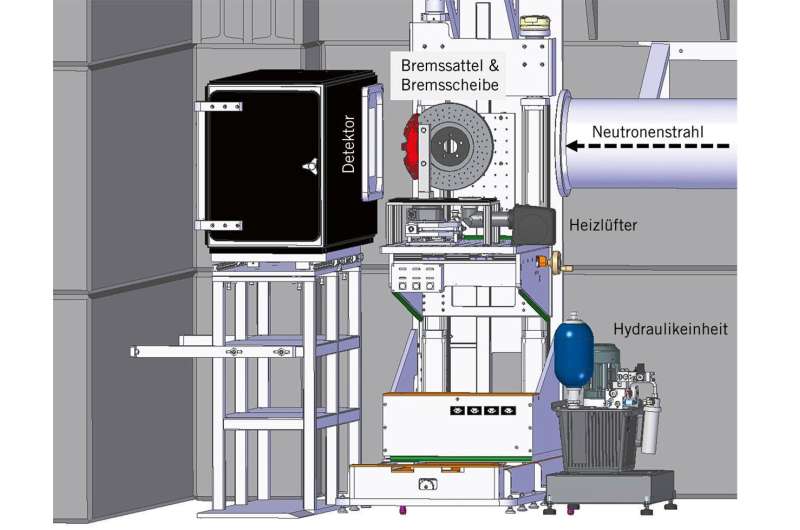Further optimizing car brakes using a neutron detector

Human lives depend on brakes. They need to grip quickly and return to their resting position immediately once the brake pedal is released. If they do not return fully, energy losses may occur. This is not noticeable to the driver and it doesn’t affect the function of the brake. It can, however, increase a vehicle’s carbon footprint.
Researchers at the Paul Scherrer Institute PSI and employees of ANAXAM and the industrial partner Audi Sport have been exploring this phenomenon. They used neutrons from the Swiss Spallation Neutron Source SINQ at PSI to look inside a brake caliper, thereby demonstrating a way of visualizing and optimizing the movement of the brake pistons. The brake caliper grips the rotating brake disc like pincers. When the driver presses the brake pedal, the hydraulic pressure from the brake line pushes a number of pistons forward, which squeeze the two brake pads—one on either side—up against the brake disc, whereupon the high frictional forces bring the disc to a stop.
ANAXAM in Villigen is a center for technology transfer, co-founded by PSI, which supports industrial companies wanting to use PSI’s research infrastructure. The industrial partner in this project was Audi Sport. Mathias Kolb, a development engineer at Audi Sport in Neckarsulm, Germany, had contacted his former colleague Matthias Wagner, now a senior engineer at ANAXAM. Together with David Mannes from PSI, they came up with a method that allows them to look inside the brake caliper in real time and search for ways of optimizing it. This has now been achieved for the first time at PSI.
Using neutrons to improve car brakes
The partners quickly realized that X-rays were ruled out by the fact that they are unable to penetrate metals. Neutrons are different: the aluminum of the brake caliper is almost transparent to them, yet at the same time they are highly sensitive to light chemical elements. This means that brake fluid, which contains hydrogen compounds, is clearly visible in the image.
PSI provided the neutron beamline and its know-how for the experiments, which began in 2021 and were completed this year. The experiment was conducted at the Neutra beamline of the spallation source SINQ. A detector recorded the neutrons passing through the apparatus and ultimately produced a two-dimensional image from within the brake caliper.
ANAXAM mounted a brake caliper in front of the detector. The set-up was supplemented by a specially designed hydraulic system that produces realistic braking pressures of up to 100 bar. A climate chamber allowed the temperature of the brake caliper to be carefully controlled, simulating various operating conditions. Unlike on the road, the brake disc did not rotate during the tests.
“This, however, could be an option for future tests, to achieve even more precise results,” says Matthias Wagner from ANAXAM. That will probably not be necessary, though, because the completed series of measurements has already yielded numerous interesting findings.
The clearance is crucial
The images recorded by the detector demonstrate impressively what neutron imaging is capable of. The brake caliper is clearly visible, with its six hydraulic pistons—three on each side. So are the tiniest deviations in the travel of the pistons.
Here, it becomes apparent that the clearance of the lower piston actuating the outer brake pad—that is the distance between the brake pad in its resting position and the brake disc—is correct at 0.4 millimeters, whereas the other five pistons have a clearance of less than 0.3 millimeters. The investigators were also able to measure precisely how the brake caliper, shaped like pincers, bends outwards when the two brake pads exert pressure on it.
This project is a good example of how the scientific know-how of PSI and the competencies of ANAXAM can further improve a product that has already proven itself in series production. The industrial partner has further optimized the operation of the brake pistons, such that the clearance of the three pistons on the inner side of the brake caliper has now been increased by 0.1 millimeters when viewed under the neutron beam. This reliably separates the brake pads from the brake disc when the brakes are released. David Mannes from PSI says, “Our research can contribute to reducing the CO2 emissions of road vehicles.”
Citation:
Further optimizing car brakes using a neutron detector (2022, December 30)
retrieved 30 December 2022
from https://techxplore.com/news/2022-12-optimizing-car-neutron-detector.html
This document is subject to copyright. Apart from any fair dealing for the purpose of private study or research, no
part may be reproduced without the written permission. The content is provided for information purposes only.
For all the latest Technology News Click Here
For the latest news and updates, follow us on Google News.

